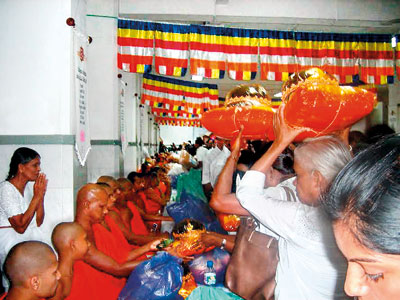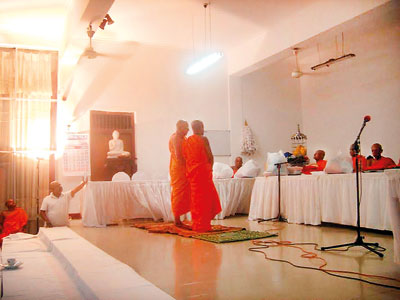Age-old rituals of Vas and the katina chivara
View(s):By Udumbara Udugama
The three months of Vassana (the rains retreat) season for bhikkhus began on the day after the Esala full moon poya on July 19 and ended on Vap full moon poya day on October 15 this year. Pera Vas is when the bhikkhus start their retreat – the day after the Esala poya. Pasu Vas is observed by bhikkhus one month later in August on Nikini poya. Monks who observed Pasu Vas cannot accept the Katina Chivara.
In the Buddha’s time, even during the rainy season monks walked about on their pindapatha (alms rounds) and for Dhamma discussions with devotees. People were not happy about this as they observed tiny insects that come out from the earth and plants that sprout up with the rains being trampled by the monks, killing the insects and destroying the plants. The Buddha was informed about this and He made a Vinaya rule permitting monks to spend the rainy season (vassana) of three months, in one place as it was difficult to journey with the rains.

Devotees offering pirikara at the Dalada Maligawa
With the end of the Vas season, Katina Chivara (robe) ceremonies are conducted in all the viharas, until Il full moon poya day on November 14. This period is known as the Katina Chivara Masaya. The practice of observing Vas is still continued in Sri Lanka and other Theravada Buddhist countries such as Thailand, Myanmar, Cambodia, Laos and even in some Buddhist viharas in the West.
Explaining the Vas season and the Katina Chivara pinkama at the Malwatte Ubhaya Maha Viharaya last Sunday, the Most Ven. Dimbulkumbure Wimaladhamma Maha Anunayaka Thera of the Malwatu Maha Viharaya said all the Upasampada (higher ordained) monks in the Malwatu Maha Viharaya have to observe the Vas season in their respective pansalas(abodes). “In the event a monk who has stayed in during the Vas season has to go out for some important work, he should get permission to do so and return on the sixth day as he is permitted to be away only within seven days. The monk who leaves and returns is not entitled to receive the Katina Chivara.”
“The Vassana season begins with the ‘Vas Aradhana’ a request by the devotees to the monks to observe the Vas season staying in their pansala. The request is made by offering a ‘dehet vattiya, (a tray of betel leaves). The monks who are willing to stay in the pansala will say a vakya (sentence) and agree to be in the pansala during the Vas season of three months. At this time, there is a close connection with the devotees who provide the monks with the “siv pasa upasthana” (alms, medicine etc.) and the monks. The devotees visit the temple to listen to Dhamma Desana (Buddhist discourses) and obtain advice from the monks.
“The practice at the Malwatu Maha Viharaya is to sound a gong on the day after the Esala Full Moon Poya and all the monks assemble at the ‘Poya ge’. They observe religious ceremonies and are ready for the Vas season which is July, August, September, ending in October with the Katina Chivara poojawa.” Once the Vassana is over, the Katina Chivara pinkamas in the viharas begin. Each Vihara decides when they should conduct the pinkama, during the Katina Chivara Masaya. Early morning, on the day of the Katina Pinkama, a white cloth is brought by a dayaka (devotee) in a procession with others participating in this meritorious deed and handed over to the monks, to make a chivara(robe). “This is cut into five pieces, stitched washed and dyed to make a robe. The robe is stitched to resemble a paddy field with niyaras(ridges). Since it is a patched robe, no one will want to steal it and also it gets rid of Tanha(craving).”
All this work is done in one day and in the afternoon, a Sanghika Dana (alms giving for the monks) is offered and the robe is presented to one monk. There are three viharas in the Malwatte, the Malwatu Maha Viharaya, Nila Aramaya and the Poyamalu Viharaya, so three Katina robes have to be prepared.
When the Sunday Times visited the Malwatu Maha Viharaya to observe the Katina ritual, three white chivara vastra(white cloth) stitched to make robes were taken on three trays by devotees under a white canopy held by four devotees, in a procession with drummers and flag bearers to the well near the Kandy lake, in front of the Viharaya. Each chivara vastra was rinsed and folded neatly while the Hewisi drummers kept drumming. The three pieces of white cloth were taken to be dyed to the Malwatu Viharaya in procession.

Handing over of the katina chivara
The Malwatu Maha Vihara Katina Pinkama was organized by the Sangharaja Gunanusmarana Samitiya and the Kantha Samitiya under the guidance of the Most Venerable Upadyaya Agramaha Panditha Aluthgama Sri Dhammarakkhita Piyadassi Dhammananda Maha Thera who will be 101 years in November. The Most Ven. Thera walked upto the well and returned to the Malwatu Maha Viharaya to mix the dyes and place the robes in the Pandu Oruwa, known as Pandu Gahanawa. The dyed robes were taken again in a procession to the hall to be handed over to three monks. Addressing the devotees, the Maha Thera said, “Mama 194 varata mehi sivuru pandu gaha thibenawa.” He has dyed 194 Katina Chivara robes and has conducted Katina Pooja at the Malwatte Viharaya on 73 occasions.
Thereafter, the Daval Sanghika Dana (Alms) and pirikara were offered to a large number of monks. The Most Ven. Dimbulkumbure Wimaladhamma Sri Saranankara Malwatu Vihara Parshawaye Anunayake Maha Thera delivered a discourse followed by chanting pirith by all the monks present. The three monks receiving the Katina Chivara were selected after discussing amongst the monks who observed the Vassana season. The Anunayaka Maha Thera then announced their names and another ritual was performed to offer these three robes. Finally, the devotees were addressed by Ven. Walpola Medhananda Maha Thera who delivered the Katina Chivara Dhamma Desana (discourse), explaining the merits of offering a Katina Chivara.
“In India, during the Buddha’s time, the Katina Chivara cloth was taken from rubbish heaps, cloth which was used to wrap a corpse.” The cloth had to be washed and cleaned. It is this custom which is still followed even today.
The Most Ven. Anunayaka Maha Thera explained how the cloth is stained. “The dyes are mixed and the white cloth is immersed in the ‘Pandu Oruwa – pandu gasanawa or pandu gaseema.’ During the Buddha’s time and even later, the monks in the village temple boiled the bark of trees and the liquid was used to stain the cloth.” Perhaps even now, in some villages, this practice may be still followed.
“Once the robe is made ready there is always a Dhamma Desana (Dhamma discourse).” Thereafter the robe is presented to the monk. As only the Upasampada (higher ordained) monks are permitted to be present at this poojawa, the samanera monks(novices) are requested to leave the Dana Salawa (hall). There is also a ‘Kapruka’, the heavenly wish conferring tree. It is a branch of a Jak tree kept for the devotees to place their offerings(pirikara), robes, soap, razors, medicine and other such items needed by the monks. At present in some viharas, the Kap Ruka is replaced by a table to place the items.
The Most Ven. Dimbulkumbure Wimaladhamma Anunayake Maha Thera explained that although there are many monks who had observed Vas in a temple, only one monk will receive the Katina Chivara. The monks discuss amongst themselves and decide on the monk who should receive the Katina Chivara. This Katina Chivara Pooja is done only once a year in a viharaya.
“The monk who receives the Kathina Chivara has five privileges but only for five months. He does not have to inform anyone when he leaves the viharaya, he can possess any number of robes, all the Sangika pirikara can be kept for himself (others have to distribute), he can request for pirikara, he can wear the Andana and one other robe (other monks have to wear the thun sivura – three robes – Andana, Thanipata Sivura and Depata Sivura). A monk’s seniority is judged by the number of Vas seasons he has spent after Upasampada,” explained the Anunayaka Thera.
“The Katina Chivara is marked with three dots placed in a corner of the robe made by placing a betel leaf and twisting with the finger to extract the juice and stain it to make the dots. The Katina Chivaraya is prepared and presented within twelve hours,” the Anunayaka Maha Thera said. It is believed that the devotee who offers the Katina Chivara receives great merit as well as the monk who receives it.

The katina vastraya being taken in procession from the Malwatte temple to be washed at the well
The offering of the Katina Chivara commenced when thirty monks who were at Saketa during their Vas (rains retreat) decided to visit the Buddha in Jetavanarama at Savasti, after the Vas Pavaranaya(ending of Vas). It rained heavily and when they arrived at Jetavanarama, the Buddha observed that they were drenched and still in their wet robes. Realizing the difficulties the monks faced, Buddha recommended an additional robe other than the three robes (Thun Sivura) already used.
It is believed that the Buddha arrived at Sankassapuraya from the Thauthisa Devlova (Deva world) on a Vap full moon day. It is also mentioned that on a Vap full moon day, King Devanampiyatissa sent Prince Attiya with a request to Emperor Dharmasoka to send a sapling of the Jayasirimaha Bodhiya to Lanka.
The Sri Dalada Maligawa Katina Chivara Poojawa was organized for the 51st time by Kothmale Sudharma Sil Meniyo of the Katukelle Lady Blake Aramaya on October 21 and 22 . On the 17th, the Katina Vastraya (White cloth) was taken in a procession to the residence of a Dayaka at Rajapihilla Mawatha, Kandy. On the 21st afternoon, there was a Dharma Desana followed by a Gilampasa Pooja in the evening at the Sri Dalada Maligawa. Early morning the next day, the Katina Vastraya and a Kap Ruka were taken to the Sri Dalada Maligawa from Rahapihilla Mawatha in a Dharma Yatra, a colourful procession. The Katina Vastraya was stitched and dyed and after an offering of Alms (Daval Dana) for over 100 monks, the Katina Chivara was offered to one monk out of the five who are resident in the Maligawa for Thevava duties, from the Asgiriya Ubhaya Maha Viharaya.


